p.61
p.65
p.69
p.73
p.77
p.81
p.85
p.89
p.93
Synthesis of Nickel Coated Gadolinia Doped Ceria Nanopowder by Microwave Radiation
Abstract:
Nickel coated gadolinium doped ceria (GDC) powder was synthesized by microwave radiation and combustion. For the synthesis, the precipitates of gadolinium cerium oxycarbonate hydrate (GdxCe2-xO(CO3)2·H2O) were formed by a microwave radiated reaction between cerium nitrate (Ce(NO3)3.6H2O) and gadolinium nitrate (Gd(NO3)3.6H2O) and urea (CO(NH2)2), then nickel coatings on the gadolinium cerium oxycarbonate hydrate were performed by further microwave reaction between nickel chloride and urea. The shape and size of the gadolinium cerium oxycarbonate hydrate particles were critically dependent on aging time during microwave radiation. The irregular particles were transformed to rod shape particles with well-crystallized with increasing aging time to 40 min at 70 - 80°C because of the gradual decomposition of urea during microwave radiation. Small nickel precursor particles were homogeneously coated on the gadolinium cerium oxycarbonate hydrate particles with rod shape with aid of microwave radiation at 80 °C for 40 min. As a result, the nickel coated GDC nanopowders were sucessfully produced by the microwave radiation synthesis and further microwave combusted at 450°C for 20 min.
Info:
Periodical:
Pages:
77-80
Citation:
Online since:
January 2008
Authors:
Keywords:
Price:
Сopyright:
© 2008 Trans Tech Publications Ltd. All Rights Reserved
Share:
Citation:


